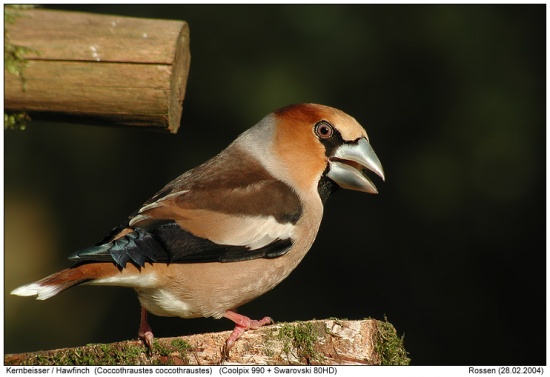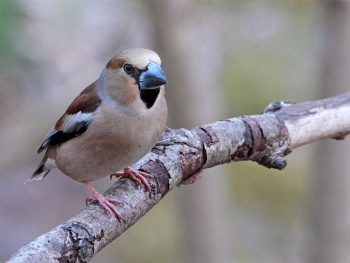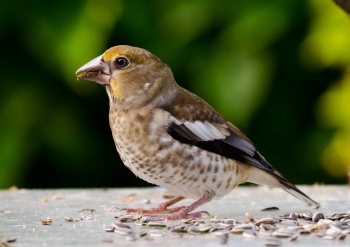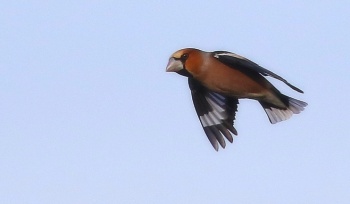- Coccothraustes coccothraustes
Identification
16-18cm (6-7 in)
Adult male
- Chestnut-brown
- Grey hind collar
- Orange-buff crown and cheeks
- Black eye patch
- Black throat
- Large white wing patch
- Black wing tips
- Very heavy stout bill (bluish-grey in summer; yellow in winter)
- Broad white tip on tail
- Flesh-coloured legs
Adult female is similar to adult male but head and rump dull brown lacking orange-brown tones; secondaries paler, not blue-black. Juvenile similar to adult but duller and spotted below.
Distribution
Breeds in southern Scotland and England and from the Pyrenees and western France to Denmark, southern Sweden and the Baltic States east to Russia and the Urals. In the south breeds in southern Iberia and North-West Africa in Morocco, north-east Algeria and north Tunisia. Also Corsica, Sardinia, and Italy, the Balkans, Greece and northern Turkey. Also breeds in the Crimea and Caucasus.
Also found in Asia from Kazakhstan, through western Afghanistan, Japan to China.
Northern and eastern populations are migratory leaving breeding areas in September-October, returning late March-early May. Elsewhere in range mainly resident or short-distance dispersal only. Winter range more widespread in western and southern Europe especially around the Mediterranean and a scarce winter visitor to the Balearics, Malta and Sicily, Crete and Cyprus and also in the Near East including Lebanon and Israel.
Vagrants recorded in Iceland, the Channel Islands, Madeira, Canary Islands, Gibraltar and Alaska
Widely distributed but generally uncommon.
Taxonomy
Subspecies
There are 5 subspecies[1]:
- C. c. coccothraustes:
- C. c. buvryi: smaller bill, greyer crown and rump and less white on wings and tail
- C. c.nigricans: darker-backed
- C. c. humii: paler, more yellowish-brown on back and mantle
- Eastern Kazakhstan to Kyrgystan, Tajikistan and western Afghanistan
- C. c. japonicus: paler, more white on belly, less white on tail tip, smaller bill
- Sakhalin, Hokkaido and northern Honshu; winters to eastern China and Bonin Island
Habitat
Usually occurs in mature deciduous or mixed woodland, often beech and hornbeam, up to 3000m. Also found in some areas in parks, large gardens and orchards. In winter may be seen in more open habitats, along hedgerows and woodland edges.
Behaviour
Often flocks after breeding.
Diet
Their diet consists of a wide variety of hard seeds, buds and shoots. They will also eat some fruit and invertebrates.
Flight
Flight strong and bounding usually at a height of around 50m. Looks front heavy and short-tailed.
Male's territorial flight is a like a bounding "roller-coaster", ending with a dive.
Breeding
They are monogamous and the pair bond may last several seasons. The nest is usually high in a deciduous tree, in a fork or against the trunk.
Vocalisation
<flashmp3>Coccothraustes coccothraustes (song).mp3</flashmp3>
Listen in an external program
References
- Clements, J. F., T. S. Schulenberg, M. J. Iliff, D. Roberson, T. A. Fredericks, B. L. Sullivan, and C. L. Wood. 2018. The eBird/Clements checklist of birds of the world: v2018. Downloaded from http://www.birds.cornell.edu/clementschecklist/download/
- Hayman, P. & R. Hume. 2002 Birdwatchers Pocket Guide, Hayman, ISBN 1-85732-804-3
- Fitter, R. 1966. Collins Pocket Guide to British Birds ISBN 1-85152-026-0
- Cramp, S. & CM Perrins (eds) 1994. Handbook of the Birds of Europe the Middle East and North Africa: The Birds of the Western Palearctic. Oxford Univ. Press.
- Clement, P. & Christie, D.A. (2019). Hawfinch (Coccothraustes coccothraustes). In: del Hoyo, J., Elliott, A., Sargatal, J., Christie, D.A. & de Juana, E. (eds.). Handbook of the Birds of the World Alive. Lynx Edicions, Barcelona. (retrieved from https://www.hbw.com/node/61420 on 25 March 2019).
- Svensson, L. & PJ Grant. 1998. Collins Bird Guide: the Most Complete Guide to the Birds of Britain and Europe. HarperCollins. ISBN 0 00 219728 6
Recommended Citation
- BirdForum Opus contributors. (2024) Hawfinch. In: BirdForum, the forum for wild birds and birding. Retrieved 31 October 2024 from https://www.birdforum.net/opus/Hawfinch
External Links







